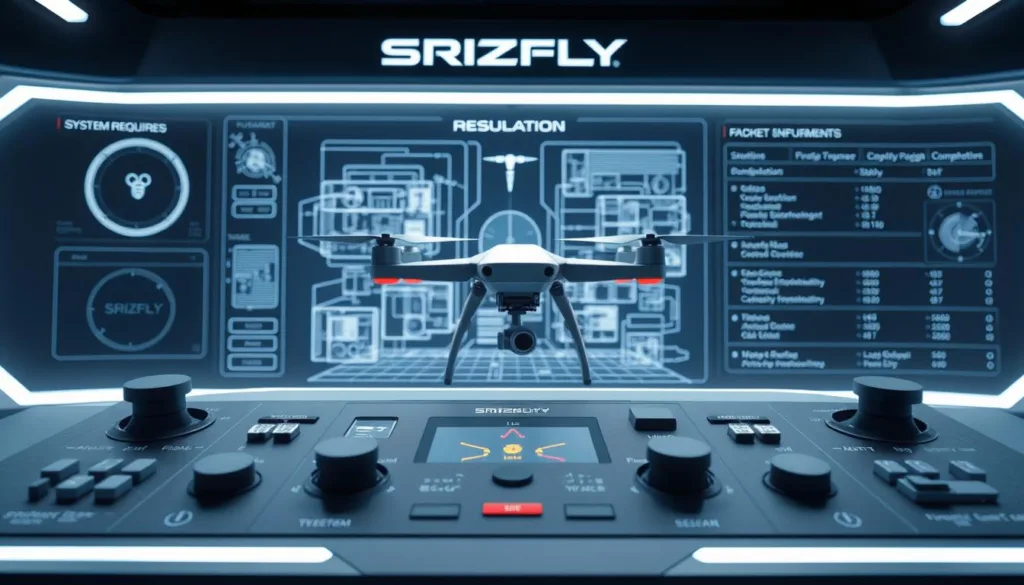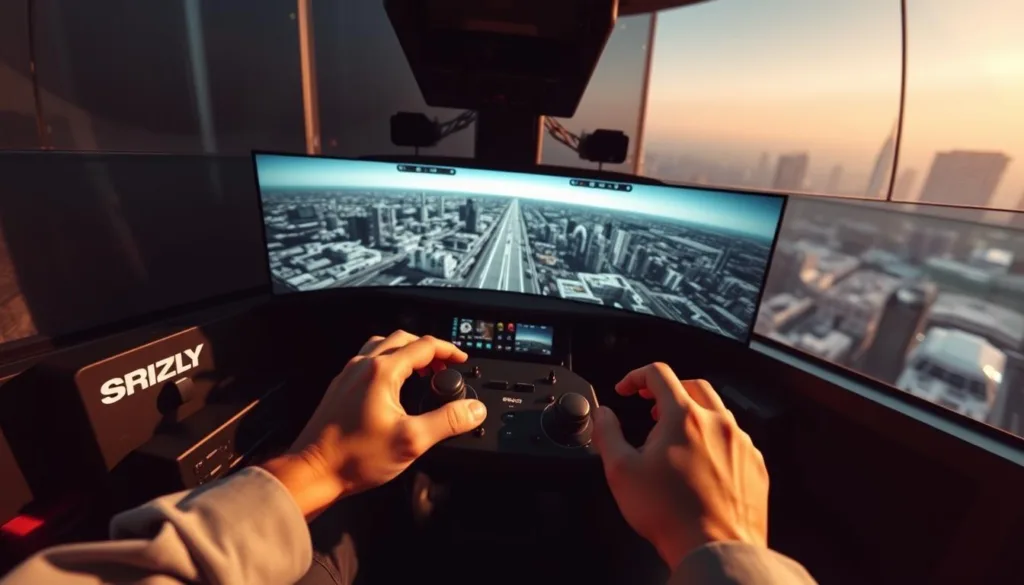Ever wanted to practice aerial maneuvers without worrying about crashes or weather? Modern simulation tools let you sharpen your piloting abilities from home. These systems recreate lifelike flying conditions, helping pilots build confidence through risk-free repetition.
Advanced training platforms offer more than basic controls. They mimic wind patterns, terrain challenges, and equipment responses just like real-world flights. This means you can test advanced techniques or recover from tricky situations before touching an actual device.
Whether you’re new to remote-controlled aircraft or refining complex tricks, simulated environments adapt to your skill level. You’ll develop crucial muscle memory through repeated practice sessions while protecting your gear from accidental damage.
The best part? These systems work with your existing goggles and controllers. Just connect your hardware, launch the software, and start exploring virtual skies. It’s like having a personal flight coach available 24/7.
Key Takeaways
- Practice flying techniques safely in realistic virtual environments
- Adapt training to different skill levels – from first-timers to experts
- Experience weather effects and terrain challenges without real-world risks
- Build muscle memory through repeatable practice sessions
- Use compatible hardware for seamless simulation-to-reality transitions
- Learn advanced recovery techniques in controlled scenarios
Introduction to DJI SIM Technology
Imagine mastering drone piloting through digital landscapes that feel as real as your backyard. Modern simulation tools have revolutionized how enthusiasts and professionals build flying skills. These platforms blend precise engineering with interactive learning, creating a safe space to push boundaries.
What Makes This Technology Unique?
The latest simulation software goes beyond basic controller practice. It replicates wind resistance, battery drain patterns, and even camera gimbal movements. One aviation instructor noted, “Trainees using these systems show 40% faster skill retention compared to traditional methods.”
Early drone simulators felt like arcade games, but today’s versions mirror real physics. Developers use actual flight data to program how virtual drones respond to commands. This attention to detail helps users transition smoothly to physical devices.
From Pixels to Professional Training
What started as simple PC games has evolved into certified training ecosystems. Modern platforms now include obstacle courses modeled after real-world locations. Pilots can practice emergency landings or navigate through virtual forests with shifting weather conditions.
These tools have become vital for everyone from hobbyists to cinematographers. By repeating maneuvers in risk-free environments, users build confidence and muscle memory. The result? Fewer crashes and sharper reflexes when it’s time for liftoff.
Key Features and Flight Training Benefits
Mastering drone flight starts with tools that mirror real-world physics. Advanced training platforms now offer features that transform virtual practice into tangible skills. These systems bridge the gap between digital rehearsal and actual takeoffs through smart design choices.
Realistic Flight Controls and Tutorials
Feel every tilt and yaw through controllers that replicate actual device responses. One pilot shared, “The virtual drone reacts exactly like my FPV model during sharp turns.” Structured tutorials guide users from basic hovering to complex flips, adapting to individual progress speeds.
Weather simulations add unexpected challenges. Gusts of wind or sudden rain tests your ability to stabilize mid-air. These controlled scenarios build quick decision-making skills without real consequences.
Enhancing Muscle Memory for Safe Flight
Repeated practice sessions create automatic responses. Wearing compatible goggles during simulations helps pilots develop spatial awareness. Your hands learn to adjust sticks instinctively when navigating tight spaces or recovering from dives.
The app’s feedback system highlights areas needing improvement. Track your reaction times or landing precision through detailed analytics. Over time, these metrics show measurable growth in control and confidence.
While some users notice slight differences in weight distribution compared to physical drones, most agree the core skills transfer seamlessly. Regular virtual drills mean fewer surprises when you switch to manual mode outdoors.
Compatible Devices and System Requirements
Before diving into virtual skies, ensure your gear meets the necessary specs. Compatibility checks prevent frustration and guarantee smooth operation during training sessions.

Supported Flight Gear
The software works seamlessly with DJI FPV Goggles V2 and both the Remote Controller 2 and Motion Controller. These tools create authentic handling experiences, letting you practice with the same equipment used in actual flights.
Optimized Mobile Performance
Your Apple device needs iOS 12.0 or newer to run the simulations. The iPad Pro stands out with its crisp display and fast processors, making complex maneuvers look stunning. iPhone Pro models deliver portable power, handling wind effects and detailed landscapes without lag.
Older hardware isn’t left behind. The 7th-gen iPad and iPhone 8 still provide decent performance for basic drills. Even the iPad Air balances affordability with capability for casual users.
One aviation instructor noted, “Students using recommended devices progress faster through advanced techniques.” Regular updates ensure compatibility across generations, so your training stays consistent as technology evolves.
User Reviews and Real-World Flight Feedback
What do actual pilots say after testing their skills in digital skies? Feedback from the community reveals how simulation tools perform under pressure – and where they could soar higher.
Positive Experiences and Insights
Many users report transformative results. “The downloaded app helped me nail coordinated turns without crashing real drones,” shared one pilot. FPV enthusiasts praise how simulations build spatial awareness through goggles, creating a safe space to experiment with complex maneuvers.
Multiple reviews highlight improved confidence during first outdoor flights. Aerial photographers note better camera control after virtual practice. The app’s tutorials receive praise for breaking down advanced techniques into digestible lessons.
Areas for Improvement
Some users face technical hurdles. Connectivity issues between goggles and devices remain a common complaint. “Every 10 minutes, my screen freezes mid-flight,” reported an FPV trainee. Others mention occasional lag during rapid movements, affecting precision.
New pilots sometimes find the simulated drone behavior differs from physical models. One review noted, “Virtual wind responses feel smoother than real gusts.” Despite these challenges, most agree the core training value outweighs temporary glitches.
Developers actively use this feedback, rolling out updates every 6-8 weeks. Recent patches improved goggle compatibility and added more realistic weight simulations. As the community grows, so does the collective knowledge for mastering both virtual and actual flights.
Exploring DJI Virtual Flight and Simulator Tools
Step into a virtual cockpit where every maneuver sharpens real-world expertise. While DJI Virtual Flight stopped updates in March 2024, its existing features remain valuable for skill development. The app combines lifelike locations with structured tutorials, creating a risk-free space to master FPV techniques.
Mastering the Training Environment
The interface prioritizes accessibility. Color-coded menus guide pilots through flight tracks and environmental settings. “I went from shaky hover attempts to smooth figure-eights in three sessions,” shared a photography enthusiast. Interactive challenges adapt to your progress, gradually introducing wind resistance and obstacle navigation.
Built-in tutorials break down complex moves like power loops. Visual indicators show throttle positioning and yaw adjustments. These tools help build confidence before tackling physical drones.
Third-party alternatives now fill gaps left by discontinued updates. New platforms offer customizable weather patterns and expanded aircraft models. Exploring different systems helps pilots identify which features align with their goals – whether cinematic filming or racing drills.
While the original app remains functional, updated simulator tools provide advanced analytics. Track reaction times or compare flight paths across attempts. This data-driven approach turns casual practice into targeted skill-building sessions.
How to Get Started with dji sim
Ready to transform your computer into a flight training hub? Professional simulation tools offer structured learning paths for pilots at every level. Choose between consumer-friendly apps or advanced enterprise solutions based on your goals.

Installation and Setup Guide
First, verify your Windows PC meets minimum specs. A GTX 1050 Ti GPU and 16GB RAM handle basic drills, while complex scenarios demand higher-end components like an i7 processor. Connect your DJI remote controller before launching the software.
Enterprise users need extra storage space for custom training modules. One aviation instructor advised, “Allocate separate drives for simulation files to prevent system lag during intensive sessions.” Always update graphics drivers for optimal visual rendering.
Essential Tips for Beginners
Start with hover challenges before attempting obstacle courses. The free trial version includes beginner-friendly tutorials that teach emergency landing protocols. Track progress through the software’s analytics dashboard to identify weak spots.
Enterprise platforms unlock specialized scenarios like power line inspections. These tools justify their cost through detailed performance reports and team training features. Use official support channels if controller calibration issues arise.
Advanced pilots recommend practicing maneuvers in windy virtual environments first. This builds adaptability before real-world flights. Remember – consistent virtual drills create muscle memory that translates to confident outdoor operations.
Conclusion
Modern drone training has evolved beyond open fields and trial-and-error crashes. Advanced simulation tools now let pilots master everything from basic hovering to complex inspection routines. These platforms bridge the gap between virtual practice and real-world scenarios through precise equipment matching.
From consumer-focused Mavic models to enterprise-ready Matrice 200 series drones, the technology adapts to your exact gear. The Inspire series and Matrice 600 prototypes behave identically in simulations and physical flights. This consistency helps professionals develop mission-critical skills safely.
Compatibility extends beyond aircraft. Whether you’re using an iPad Pro 1st gen or iPhone Pro Max, the software optimizes performance across devices. Enterprise versions even support specialized configurations like the Matrice 100’s dual-operator setups.
Practice becomes power when your virtual training matches real equipment. The right goggles and controllers create muscle memory that translates directly to fieldwork. Explore these tools through the official store’s trial programs – your next breakthrough might start with a simulated flight.
FAQ
Which devices work with DJI’s flight simulator?
The training tool supports iPad Pro (1st and 2nd gen), iPad Air, and iPhone Pro Max models running iOS 12.0 or newer. It’s also compatible with remote controllers for the FPV series, Avata, Matrice 200/600, and Inspire drones.
Can beginners practice safely before flying real drones?
Absolutely! The simulator mimics real-world physics, wind conditions, and obstacle scenarios. Users build muscle memory through tutorials and adaptive challenges, reducing risks during actual flights.
Does the app require additional hardware?
You’ll need a compatible DJI remote controller or goggles linked to your Apple device. Enterprise-grade drones like the Matrice 300 series may need specific firmware updates for full functionality.
How does this tool help professional pilots?
Advanced features like battery management simulations, emergency response drills, and mission planning prepare users for complex tasks in industries like inspection, mapping, or cinematography.
Are there in-app tutorials for new features?
Yes! Updated modules cover gesture controls for the Avata, waypoint navigation for Matrice drones, and low-light flying techniques. These tutorials adapt based on skill level and hardware.
What improvements have users requested?
Some pilots want expanded Android support, more urban environment scenarios, and multiplayer modes for team training. DJI frequently updates the software based on this feedback.



